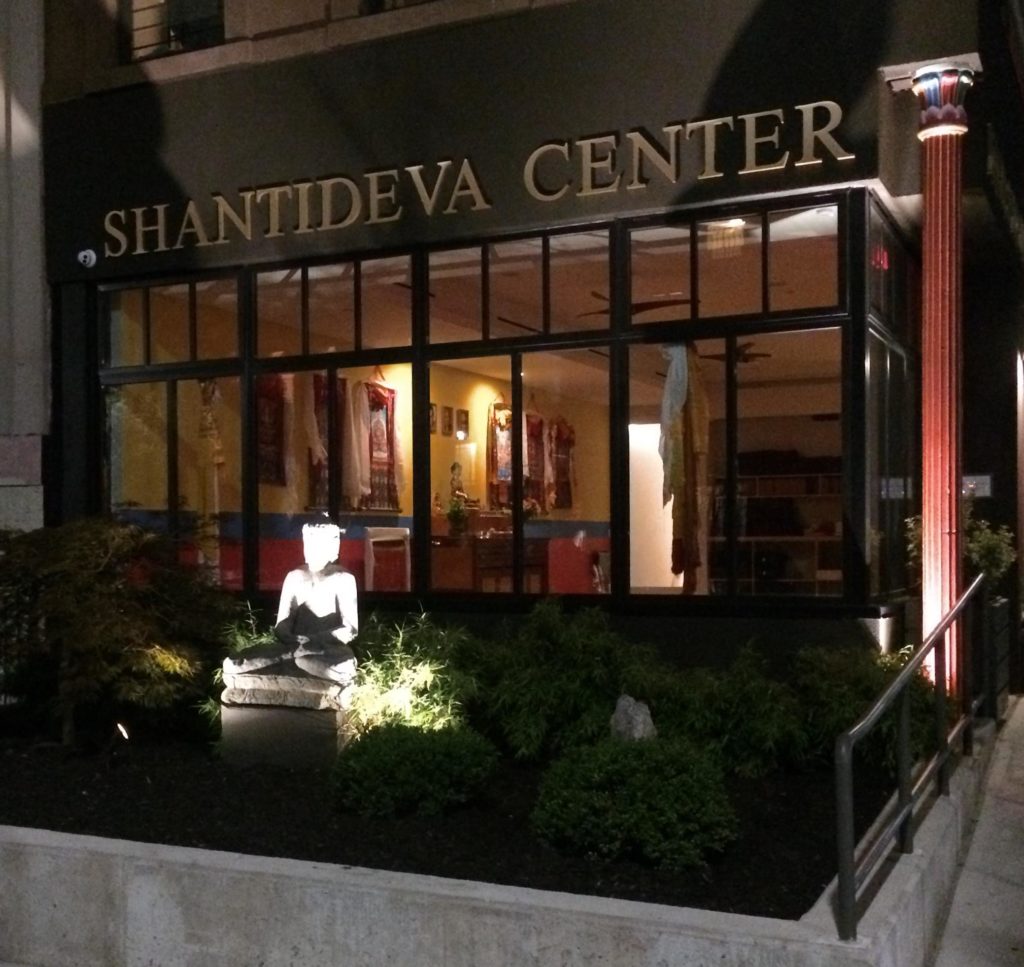Getting Started
Welcome! We’re so happy you came! We hope this introduction is helpful for you to prepare for your first visit to the Center.
If you have any other questions, please send us an email. It will be our pleasure to help you.

Your First Visit
Please remove your shoes and place them in the cubbies near the door, and hang your hat. There are also hooks for hanging your coat.
Next, visit our friendly volunteer at the reception desk to check in or register for your class or to make your offering. They will let you know where everything is and answer any questions you may have.
Once you’ve signed in, please:
- Relax with complimentary tea and cookies
- Help yourself to a free book from the Lama Yeshe Wisdom Archive display
- Pick up any of our brochures, postcards, or flyers
- Explore the wonderful offerings in our shop
If you arrive early for your class, you may enter the meditation hall and settle into the tranquil atmosphere, or relax in the reception area, which is open before and after classes. The gong will sound five minutes before class begins.
The Dharma is offered freely, but the center, which is a non-profit organization, is run by volunteer staff and relies on your generous support to pay operating expenses and to help support our visiting teachers. For this reason, there is a suggested offering amount for most center activities.
We are grateful for all contributions, which help us to keep our doors open in service of the community. If you would like information on how you can help sustain the center, please consider making a donation.
*Note: Yoga at Shantideva Center is offered by Yogis & Yoginis, which is not affiliated with Shantideva Center (FPMT – NYC) and has its own policies. Please visit Yoga.
You may wish to bring a pen and notebook or a device to take notes during Dharma classes. Shantideva Center makes every effort to be environmentally conscious and to preserve the planet’s resources. For Dharma classes and teachings, texts are projected onto a screen. In addition, when you register online, you will be given access to the texts so that you can bring them on your device (or print them if you prefer). For pujas and practices, the center distributes the texts in print to be shared and returned.
A gompa is a Buddhist sacred space used for meditation, prayers, rituals, and teachings. Because we consider the Buddha’s teachings to be extremely precious, we treat them with great respect. It is said that the more we respect the teachings, the more we will be open to and benefit from them. This translates into traditional ways of showing respect to Dharma teachers, books, and the place where teachings are held. Whether you or Buddhist or not, we ask you to follow these customs out of respect for the tradition:
- Please do not bring food and drink (including water bottles) into the gompa.
- Many students offer three prostrations to the Buddha when entering the gompa. This is not obligatory.
- Before a formal teaching, it is customary to stand in silence while awaiting the teacher’s arrival. When the teacher enters, we bow, holding our hands together in the prostration mudra until the teacher is seated. Once the teacher is seated, we may offer them three prostrations before sitting down.
- After a formal teaching, it is customary to stand in silence until the teacher has left.
- Please do not point the soles of your feet toward the altar or the teacher.
- When sitting on a cushion, please do not recline during teachings. Instead, maintain an alert yet relaxed posture to show respect to the teachings and the teacher.
Programs for Beginners
We have classes and events for all levels of practice, including introductory courses for brand new students or those who are just curious about Buddhism.
Meditation 101 is an introductory five-session course designed for complete beginners. This class provides an overview of Buddhist meditation and basic meditation techniques, including breathing, mindfulness, visualization, and analytical meditation. The course includes an explanation of what kinds of skills we develop in meditation and how these are useful in our daily lives.
Buddhism in a Nutshell is an introductory course in Tibetan Buddhism meant for complete beginners. It offers a general overview of basic Buddhist philosophy and principles along with a brief introduction to Tibetan Buddhist meditation.
Questions About Buddhism
The resources below are from FPMT’s New to Buddhism FAQ page:
Click here for “What is Buddhism” by Lama Zopa Rinpoche.
There are many ways to describe who the Buddha is, according to different ways of understanding. These various interpretations have their sources in the Buddha’s teachings. One way is to see the historical Buddha who lived 2,500 years ago as a human being who cleansed his mind of all defilements and developed all his potential. Any being who does likewise is also considered a Buddha, for there are many Buddhas, not just one. Another way is to understand a particular Buddha or Buddhist deity as omniscient mind manifesting in a certain physical aspect in order to communicate with us. Yet another way is to see the Buddha — or any of the enlightened Buddhist deities — as the appearance of the future Buddha that we will become once we properly and completely have engaged in the path to cleanse our mind of defilements and develop all our potentials.
The Three Jewels are the Buddha, Dharma and Sangha. Buddha is one who has purified all the defilements of the mind the afflictive emotions, the imprints of the actions motivated by them, and the stains of these afflictive emotions and who has developed all good qualities, such as impartial love and compassion, wisdom knowing all existence, and skillful means of guiding others. The Dharma embodies the preventive measures which keep us from problems and suffering. This includes the teachings of the Buddha, as well as the realizations of those teachings the cessations of problems and their causes, and the realizations or paths which lead to those cessations. The Sangha are those beings who have direct non-conceptual perception of emptiness or ultimate truth. On a relative level, Sangha also refers to the ordained people who put the Buddha’s teachings into practice.
Simply speaking, this is to avoid harming others and to help them as much as possible. Another way of expressing this is: abandon negative action; create perfect virtue; subdue your own mind. This is the teaching of the Buddha. By abandoning negative actions (killing, etc.) and destructive motivations (anger, attachment, close-mindedness, etc.), we stop harming ourselves and others. By creating perfect virtue, we develop beneficial attitudes, like impartial love and compassion, and do actions motivated by these thoughts. By subduing our mind, we cut away all false projections, thus making ourselves calm and peaceful by understanding reality. The essence of Buddha’s teachings is also contained in the three principles of the path: definite emergence, the dedicated heart and wisdom realizing emptiness. Initially, we seek definitely to emerge from the confusion of our problems and their causes. Then, we see that other people also have problems, and with love and compassion, we dedicate our heart to becoming a Buddha so that we are capable of helping others extensively. In order to do this, we develop the wisdom understanding the real nature of ourselves and other phenomena.
The Buddha gave a wide variety of teachings because sentient beings (any being with a mind who is not a Buddha, including those in other realms of existence) have different dispositions, inclinations and interests. The Buddha never expected us all to fit into the same mold. Thus, he gave many teachings and described various ways of practicing so each of us could find something that suits our level of mind and our personality.
Generally, there are two divisions: Theravada and Mahayana. The Theravada lineage (Tradition of the Elders), which relies on sutras recorded in the Pali language, spread from India to Sri Lanka, Thailand, Burma, etc. It emphasizes meditation on the breath to develop concentration and meditation on mindfulness of the body, feelings, mind and phenomena in order to develop wisdom. The Mahayana (Great Vehicle) tradition, based on the scriptures recorded in Sanskrit, spread to China, Tibet, Japan, Korea, Vietnam, etc. Although in the Theravadin practice love and compassion are essential and important factors, in the Mahayana they are emphasized to an even greater extent. Shantideva Center practices Tibetan Buddhism in the Gelug tradition. Click here for a short summary of Tibetan Buddhism.


